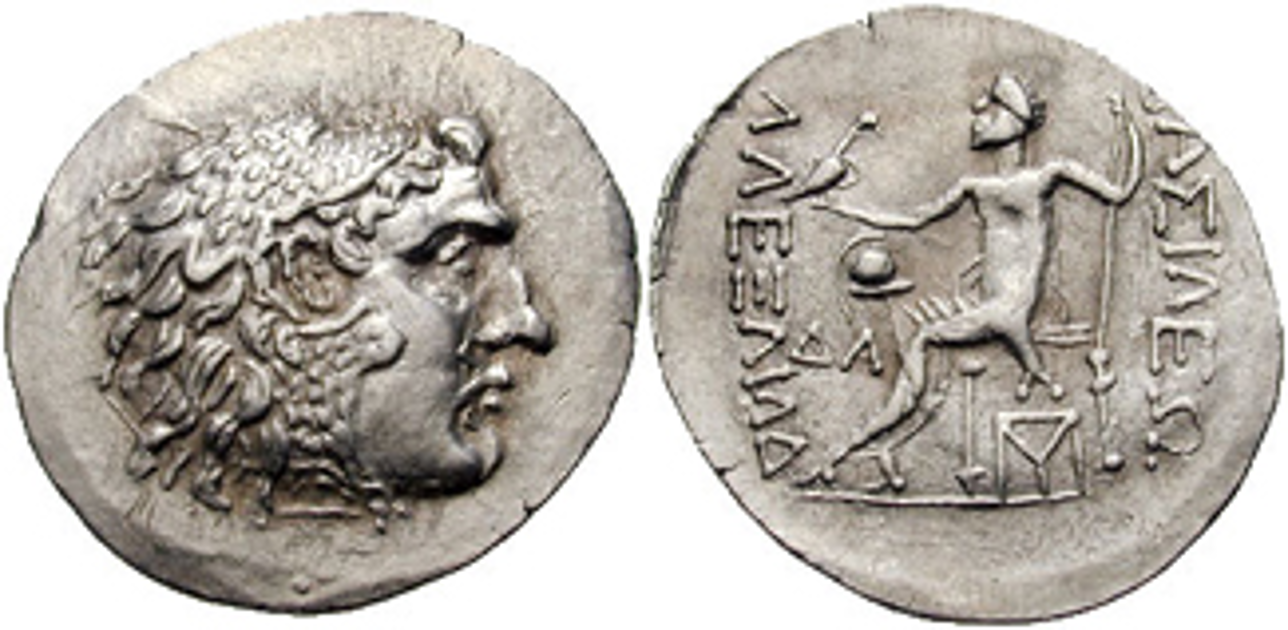175 BCE - 125 BCE | BAΣΙΛΕΩ AΛΕΞΛΙΛΔ
Overstriking coin
SO 833 - Mesembria (Alexander the Great) over Thasos.png
Overstruck variety
Thasos tetradrachm.jpg
|
|
Sale(s)Sale(s) ᵖ:
|
Classical Numismatic Group Webshop April 2017, lot 727792.
|
|
|
|
Description
| ObverseInscription or printing placed on the obverse.:
|
Head of Herakles right, wearing lion skin headdress.
|
ReverseInscription or printing placed on the reverse.:
|
BAΣΙΛΕΩ AΛΕΞΛΙΛΔ (Greek) Zeus enthroned left, holding eagle and scepter. Under the throne, monogram (ΠΥ). In left field, Corinthian crested helmet and ΔΑ.
|
Mint and issuing power
| MintIdentifies the place of manufacture or issue of a numismatic object.:
|
Mesembria
|
Ancient regionAncient region.
|
Thrace
|
Modern countryModern country: Bulgaria
|
AuthorityIdentifies the issuing power. The authority can be "pretended" when the name or the portrait of X is on the coin but he/she was not the issuing power. It can also be "uncertain" when there is no mention of X on the coin but he/she was the issuing power according to the historical sources:
|
Alexander III the Great (Argead king, 336-323 BC)
|
Chronology
| FromIdentifies the initial date in a range assigned in a numismatic context. 175 BCE toIdentifies the final date in a range assigned in a numismatic context.. 125 BCE
|
hellenistic periodTime period of the numismatic object.
|
Physical description
MetalThe physical material (usually metal) from which an object is made.: Silver 
|
WeightWeight of the numismatic object (in grams). in grams: 16.4216.42 g <br />16,420 mg <br />
|
DenominationTerm indicating the value of a numismatic object. Examples: tetradrachm, chalkous, denarius.: tetradrachm 
|
|
|
|
StandardStandard.: Attic
|
References
Description
| ObverseInscription or printing placed on the obverse.:
|
Head of Dionysos right, wearing ivy wreath (visible: slight traces).
|
ReverseInscription or printing placed on the reverse.:
|
HPAKΛEOYΣ ΣΩΤΗΡΟΣ ΘΑΣΙΩΝ (Greek) Herakles standing, nude, holding lion skin and club. In field, letter or monogram.
|
Mint and issuing power
| MintIdentifies the place of manufacture or issue of a numismatic object. ᵖ:
|
Thasos
|
Ancient regionAncient region. ᵖ
|
Thrace
|
Modern countryModern country: Greece
|
AuthorityIdentifies the authority in whose name (explicitly or implicitly) a numismatic object was issued. ᵖ:
|
|
Chronology
| FromIdentifies the initial date in a range assigned in a numismatic context. toIdentifies the final date in a range assigned in a numismatic context..
|
periodTime period of the numismatic object.
|
Physical description
| DenominationTerm indicating the value of a numismatic object. Examples: tetradrachm, chalkous, denarius. ᵖ:
|
tetradrachm 
|
StandardStandard. ᵖ:
|
Attic
|
References
| Frequency of overstrikesFrequency of overstrikes:
|
|
Level of confidenceLevel of confidence of the identification:
|
|
| RemarksRemarks:
|
This coin is from a small hoard, of which many were overstruck on Thasos tetradrachms. This particular example shows faint traces of the lettering on the reverse below the throne,and within the letters of the right legend. There are also traces below the obverse portrait of Herakles. In addition, this reverse die was die-linked to another specimen that exhibited more obvious traces of an overstrike.
|
References
- ^ Price, Martin Jessop (1991), The Coinage in the Name of Alexander the Great and Philip Arrhidaeus: a British Museum Catalogue, 2 vol., Zürich-London, 637 p., 637 p., clix pl.
- ^ Karayotov, Ivan (1994), The coinage of Mesambria. vol. 1: silver and gold coins of Mesambria, Centre of Underwater Archaeology, Sozopol, 134 p. and 44 pl.

